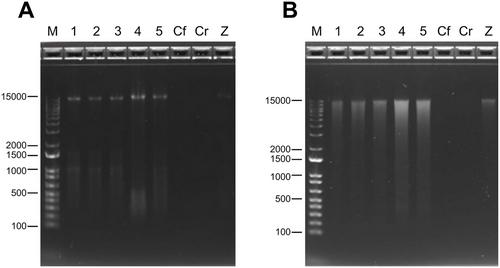{"title":"Nanopore-Enabled Microbiome Analysis: Investigating Environmental and Host-Associated Samples in Rainbow Trout Aquaculture","authors":"Giulia Zarantonello, Argelia Cuenca","doi":"10.1002/cpz1.1069","DOIUrl":null,"url":null,"abstract":"<p>Microbiome sequencing is at the forefront of health management development, and as such, it is becoming of great interest to monitor the microbiome in the aquaculture industry as well. Oxford Nanopore Technologies (ONT) platforms are gaining popularity to study microbial communities, enabling faster sequencing, extended read length, and therefore, improved taxonomic resolution. Despite this, there is a lack of clear guidelines to perform a metabarcoding study, especially when dealing with samples from non-mammalian species, such as aquaculture-related samples. In this article, we provide general guidelines for sampling, nucleic acid extraction, and ONT-based library preparation for both environmental (water, sediment) and host-associated (gill or skin mucus, skin, gut content, or gut mucosa) microbiome analysis. Our procedures focus specifically on rainbow trout (<i>Oncorhynchus mykiss</i>) reared in experimental facilities. However, these protocols can also be transferred to alternative types of samples, such as environmental DNA (eDNA) monitoring from alternative water sources, or to different fish species. The additional challenge posed by the low biomass and limited bacterial diversity inherent in fish-associated microbiomes is addressed through the implementation of troubleshooting solutions. Furthermore, we describe a bioinformatic pipeline starting from raw reads and leading to taxonomic abundance tables using currently available tools and software. Finally, we provide a set of specific guidelines and considerations related to the strategic planning of a microbiome study within the context of aquaculture. © 2024 The Authors. Current Protocols published by Wiley Periodicals LLC.</p><p><b>Basic Protocol 1</b>: Environmental sample collection</p><p><b>Basic Protocol 2</b>: Host-associated sample collection</p><p><b>Alternate Protocol</b>: Host-associated sample collection: Alternative sample types</p><p><b>Basic Protocol 3</b>: Sample pre-treatment and nucleic acid extraction</p><p><b>Basic Protocol 4</b>: Quality control and preparation for 16S rRNA gene sequencing</p><p><b>Support Protocol 1</b>: Assessment of inhibition by quantitative PCR</p><p><b>Support Protocol 2</b>: Bioinformatic analysis from raw files to taxonomic abundance tables</p>","PeriodicalId":93970,"journal":{"name":"Current protocols","volume":null,"pages":null},"PeriodicalIF":0.0000,"publicationDate":"2024-06-12","publicationTypes":"Journal Article","fieldsOfStudy":null,"isOpenAccess":false,"openAccessPdf":"https://onlinelibrary.wiley.com/doi/epdf/10.1002/cpz1.1069","citationCount":"0","resultStr":null,"platform":"Semanticscholar","paperid":null,"PeriodicalName":"Current protocols","FirstCategoryId":"1085","ListUrlMain":"https://onlinelibrary.wiley.com/doi/10.1002/cpz1.1069","RegionNum":0,"RegionCategory":null,"ArticlePicture":[],"TitleCN":null,"AbstractTextCN":null,"PMCID":null,"EPubDate":"","PubModel":"","JCR":"","JCRName":"","Score":null,"Total":0}
引用次数: 0
Abstract
Microbiome sequencing is at the forefront of health management development, and as such, it is becoming of great interest to monitor the microbiome in the aquaculture industry as well. Oxford Nanopore Technologies (ONT) platforms are gaining popularity to study microbial communities, enabling faster sequencing, extended read length, and therefore, improved taxonomic resolution. Despite this, there is a lack of clear guidelines to perform a metabarcoding study, especially when dealing with samples from non-mammalian species, such as aquaculture-related samples. In this article, we provide general guidelines for sampling, nucleic acid extraction, and ONT-based library preparation for both environmental (water, sediment) and host-associated (gill or skin mucus, skin, gut content, or gut mucosa) microbiome analysis. Our procedures focus specifically on rainbow trout (Oncorhynchus mykiss) reared in experimental facilities. However, these protocols can also be transferred to alternative types of samples, such as environmental DNA (eDNA) monitoring from alternative water sources, or to different fish species. The additional challenge posed by the low biomass and limited bacterial diversity inherent in fish-associated microbiomes is addressed through the implementation of troubleshooting solutions. Furthermore, we describe a bioinformatic pipeline starting from raw reads and leading to taxonomic abundance tables using currently available tools and software. Finally, we provide a set of specific guidelines and considerations related to the strategic planning of a microbiome study within the context of aquaculture. © 2024 The Authors. Current Protocols published by Wiley Periodicals LLC.
Basic Protocol 1: Environmental sample collection
Basic Protocol 2: Host-associated sample collection
Alternate Protocol: Host-associated sample collection: Alternative sample types
Basic Protocol 3: Sample pre-treatment and nucleic acid extraction
Basic Protocol 4: Quality control and preparation for 16S rRNA gene sequencing
Support Protocol 1: Assessment of inhibition by quantitative PCR
Support Protocol 2: Bioinformatic analysis from raw files to taxonomic abundance tables

纳米孔微生物组分析:调查虹鳟养殖中的环境和宿主相关样本。
微生物组测序处于健康管理发展的前沿,因此,监测水产养殖业的微生物组也变得非常重要。牛津纳米孔技术(ONT)平台在研究微生物群落方面越来越受欢迎,因为它可以加快测序速度,延长读取长度,从而提高分类分辨率。尽管如此,目前仍缺乏进行代谢条码研究的明确指南,尤其是在处理非哺乳动物物种样本时,如水产养殖相关样本。在本文中,我们为环境(水、沉积物)和宿主相关(鳃或皮肤粘液、皮肤、肠道内容物或肠道粘膜)微生物组分析提供了取样、核酸提取和基于 ONT 的文库制备的一般指南。我们的程序专门针对在实验设施中饲养的虹鳟鱼(Oncorhynchus mykiss)。不过,这些程序也可用于其他类型的样本,如对其他水源的环境 DNA(eDNA)监测,或用于不同的鱼类物种。鱼类相关微生物组固有的低生物量和有限的细菌多样性带来了额外的挑战,我们通过实施故障排除解决方案来解决这一问题。此外,我们还介绍了一种生物信息学管道,它从原始读数开始,利用现有工具和软件生成分类丰度表。最后,我们提供了一套与水产养殖微生物组研究战略规划相关的具体指南和注意事项。© 2024 作者。当前协议》由 Wiley Periodicals LLC 出版。基本方案 1:环境样本采集 基本方案 2:宿主相关样本采集 替代方案:宿主相关样本采集:基本方案 3:样品预处理和核酸提取 基本方案 4:质量控制和 16S rRNA 基因测序准备 支持方案 1:通过定量 PCR 评估抑制作用 支持方案 2:从原始文件到分类丰度表的生物信息分析。
本文章由计算机程序翻译,如有差异,请以英文原文为准。


